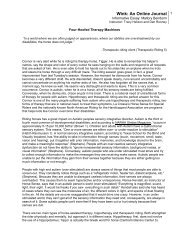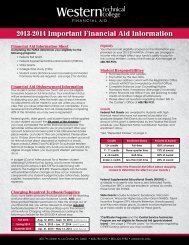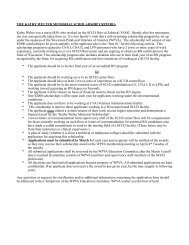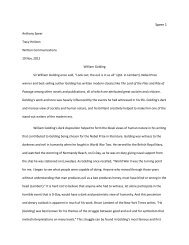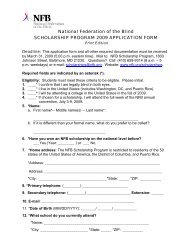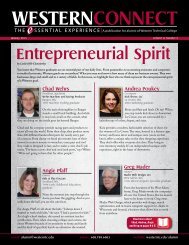The History of Western Technical College
The History of Western Technical College
The History of Western Technical College
Create successful ePaper yourself
Turn your PDF publications into a flip-book with our unique Google optimized e-Paper software.
Where did it all begin?<br />
We frequently read the sentence that our vocational-technical school (WWTC) was established in 1912<br />
following legislation that was enacted in 1911. But, what was that legislation all about?<br />
<strong>The</strong> Beginning<br />
Our School<br />
In the early years <strong>of</strong> the 20 th Century, education was a scarce commodity. In rural Wisconsin, in 1900, over half<br />
<strong>of</strong> the students quit by fifth grade - only one in thirty graduated from high school. For most, there was no need<br />
for more education. Wisconsin's agricultural, forestry, and mining economies called for physical labor. Going<br />
back to school was simply not something adults did. However as automation required workers to have more<br />
skills, the 1900's brought out a need for education that had not existed before.<br />
Charles McCarthy, a Massachusetts native, saw that need. He was concerned about the young people who had<br />
left school and who could never better themselves. Although he was not an educator, he held a PhD in <strong>History</strong><br />
from the University <strong>of</strong> Wisconsin. McCarthy educated himself so successfully that he was admitted to the<br />
University <strong>of</strong> Wisconsin after writing examinations proving that he had attained the equivalent <strong>of</strong> a high school<br />
diploma. He was head <strong>of</strong> the State Legislative Reference Library, an agency that drafted legislation. McCarthy<br />
was a strong supporter <strong>of</strong> the movement called "<strong>The</strong> Wisconsin Idea", a collection <strong>of</strong> Progressive ideas, and<br />
spoke out for public education and government reform. "<strong>The</strong> Wisconsin Idea" produced changes such as<br />
election reforms, regulatory commissions, civil service laws, and conservation laws.<br />
Labor and industry were becoming aware <strong>of</strong> their responsibilities to help people meet the challenges <strong>of</strong> the<br />
changing times. Wisconsin State legislators were persuaded by McCarthy to further educational opportunity by<br />
encouraging localities to set up the first vocational schools.<br />
In 1909, McCarthy mobilized legislative support for a study <strong>of</strong> Wisconsin's educational situation. McCarthy<br />
wrote the study that recommended continuation schools for boys and girls who had quit school. <strong>The</strong> study also<br />
recommended evening schools for adults, trade schools, and formal education for apprentices since<br />
apprenticeship was unregulated at that time. That study became the nucleus <strong>of</strong> the 1911 Laws for Industrial<br />
and Continuing Education.<br />
In 1911, legislation was passed providing what McCarthy had recommended. Wisconsin was the first state to<br />
establish a system <strong>of</strong> state support for vocational, technical and adult education (Chapter 616, Laws <strong>of</strong> 1911).<br />
<strong>The</strong> law appropriated state aid for continuation, trade and evening schools; required every community with a<br />
population <strong>of</strong> 5,000 or more to establish a local Board <strong>of</strong> Industrial Education comprised <strong>of</strong> two members<br />
representing industry, two members representing labor, and the local Superintendent <strong>of</strong> Schools; and<br />
authorized the local boards to levy a property tax up to one-half mill.<br />
<strong>The</strong> 1911 legislation also created a nine-member State Board <strong>of</strong> Industrial Education consisting <strong>of</strong> three<br />
employers, three employees, the dean <strong>of</strong> the University <strong>of</strong> Wisconsin Engineering Department, the dean <strong>of</strong> the





